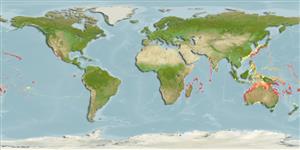Actinopterygii (ray-finned fishes) >
Perciformes (Perch-likes) >
Labridae (Wrasses) > Bodianinae
Etymology: Bodianus: Bodianus after Bodiano or Pudiano, from the Portuguese pudor, meaning modesty (Jordan & Evermann, 1896).; perditio: Name from the masculine Latin noun perditis or destruction; referring to the precarious
position in which the vessel 'Astrolabe' found itself around the time the holotype was collected.
Issue
Junior synonym Cossyphus astrolumbus Valenciennes, 1839 (in Bodianus) is a valid species according to Randall & Victor, 2013 (Ref. 96378).
Environment / Climate / Range
Ecology
Marine; reef-associated; non-migratory; depth range 10 - 120 m (Ref. 89972). Subtropical, preferred ?
Antiequatorial. Indo-West Pacific: southern Africa to the islands of southern Oceania. Western Central Pacific: From Taiwan to southern Japan.
Size / Weight / Age
Maturity: Lm ? range ? - ? cm
Max length : 80.0 cm SL male/unsexed; (Ref. 9823); max. published weight: 312.00 g (Ref. 3132)
This species is reported to be found on deep offshore reefs as adults, but juveniles may occur as shallow as 9 m (Ref. 75973). Also, adults inhabit the vicinity of coral and rocky reefs, often over sand or rubble in deeper water. Feed mainly on benthic invertebrates such as mollusks and crustaceans (Ref. 9823). Oviparous, distinct pairing during breeding (Ref. 205). An excellent food fish (Ref. 3132).
Life cycle and mating behavior
Maturity | Reproduction | Spawning | Eggs | Fecundity | Larvae
Oviparous, distinct pairing during breeding (Ref. 205).
Gomon, M.F., 2006. A revision of the labrid fish genus Bodianus with descriptions of eight new species. Rec. Aust. Mus. Suppl. 30:1-133. (Ref. 75973)
IUCN Red List Status (Ref. 115185)
CITES (Ref. 94142)
Not Evaluated
Threat to humans
Harmless
Human uses
Fisheries: commercial; gamefish: yes; aquarium: commercial
More information
ReferencesAquacultureAquaculture profileStrainsGeneticsAllele frequenciesHeritabilityDiseasesProcessingMass conversion
Tools
Special reports
Download XML
Internet sources
